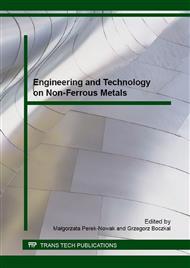[1]
R.S. Mishra, P.S. De, N. Kumar, Friction Stir Welding and Processing: Science and Engineering, Springer International Publishing, Switzerland (2014).
Google Scholar
[2]
J.H. Ouyang, R. Kovacevic, Material Flow and Microstructure in the Friction Stir Butt Welds of the Same and Dissimilar Aluminum Alloys, Journal of Materials Engineering and Performance, 11 (2002) 51-63.
DOI: 10.1007/s11665-002-0008-0
Google Scholar
[3]
Y.S. Sato, Y. Kurihara, H. Kokawa, Microstructural characteristics of dissimilar butt friction stir welds of AA7075 and AA2024, Proc. 6th Int. FSW Symp., Saint-Sauveur, Que., Canada, October 2006, TWI, CD-ROM.
Google Scholar
[4]
S.A. Khodir, T. Shibayanagi, Microstructure and Mechanical Properties of Friction Stir Welded Dissimilar Aluminum Joints of AA2024-T3 and AA7075-T6, Materials Transactions, 48 (2007) 1928-(1937).
DOI: 10.2320/matertrans.mra2007042
Google Scholar
[5]
P. Cavaliere, E. Cerri, A. Squillace, Mechanical response of 2024-7075 aluminium alloys joined by Friction Stir Welding, Journal of Materials Science 40 (2005) 3669-3676.
DOI: 10.1007/s10853-005-0474-5
Google Scholar
[6]
T. DebRoy, H.K.D.H. Bhadesia, Friction stir welding of dissimilar alloys – a perspective, Science and Technology of Welding and Joining, 15 (2010) 266-270.
DOI: 10.1179/174329310x12726496072400
Google Scholar
[7]
L.E. Murr, A Review of FSW Research on Dissimilar Metal and Alloy Systems, Journal of Materials Engineering and Performance, 19 (2010) 1071-1089.
DOI: 10.1007/s11665-010-9598-0
Google Scholar
[8]
N. Kumar, W. Yuan, R.S. Mishra, Friction Stir Welding of Dissimilar Alloys and Materials, Butterworth-Heinemann (Elsevier), (2015).
DOI: 10.1016/b978-0-12-802418-8.00004-7
Google Scholar
[9]
I. Kalemba, S. Dymek, C. Hamilton, M. Blicharski, Microstructure and mechanical properties of friction stir welded 7136-T76 aluminum alloy, Materials Science and Technology, 27 (2011) 903-908.
DOI: 10.1179/026708309x12584564052175
Google Scholar
[10]
I. Kalemba, C. Hamilton, S. Dymek, Natural Aging in Friction Stir Welded 7136-T76 Aluminum Alloy, Materials & Design 60 (2014) 295-301.
DOI: 10.1016/j.matdes.2014.04.009
Google Scholar
[11]
P. Bahemmat, M. Haghpanahi, M.K.B. Givi, K.R. Seighalani, Study on dissimilar friction stir butt welding of AA7075-O and AA2024-T4 considering the manufacturing limitation, International Journal of Advanced Manufacturing Technology 59 (2012).
DOI: 10.1007/s00170-011-3547-4
Google Scholar
[12]
S.A. Khodir, T. Shibayanagi, Friction stir welding of dissimilar AA2024 and AA7075 aluminum alloys, Materials Science and Engineering B 148 (2008) 82-87.
DOI: 10.1016/j.mseb.2007.09.024
Google Scholar
[13]
C. Hamilton, M. Kopyścianski , O.N. Senkov, S. Dymek, A Coupled Thermal/Material Flow Model of Friction Stir Welding Applied to Sc-Modified Aluminum Alloys, – Metallurgical and Materials Transaction A, 44A (2013) 1730-1740.
DOI: 10.1007/s11661-012-1512-y
Google Scholar
[14]
P.L. Threadgill, A.J. Leonard, H.R. Sherliff, P.J. Withers, Friction stir welding of aluminum alloys International Materials Review 54 (2009) 49-93.
DOI: 10.1179/174328009x411136
Google Scholar
[15]
I. Kalemba, C. Hamilton, S. Dymek, Natural Aging in Friction Stir Welded 7136-T76 Aluminum Alloy, Materials & Design 60 (2014) 295-301.
DOI: 10.1016/j.matdes.2014.04.009
Google Scholar
[16]
S. -K. Park, S. -T. Hong, J. -H. Park, K. -Y. Park, Y. -Y. Kwon, H. -J. Son, Effect of material locations on properties of friction stir welding joints of dissimilar aluminium alloys, Science and Technology of Welding and Joining, 15 (2010).
DOI: 10.1179/136217110x12714217309696
Google Scholar


